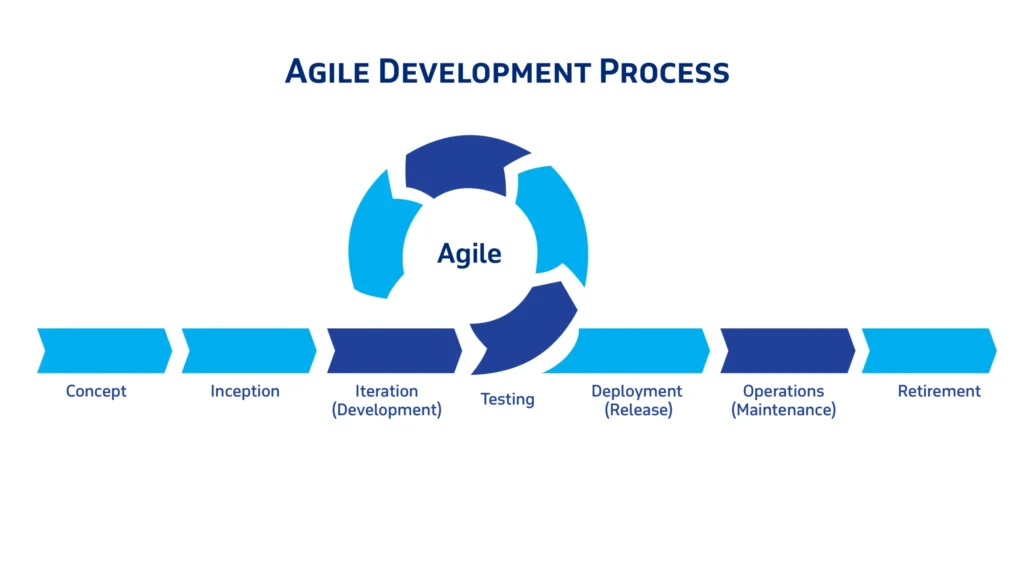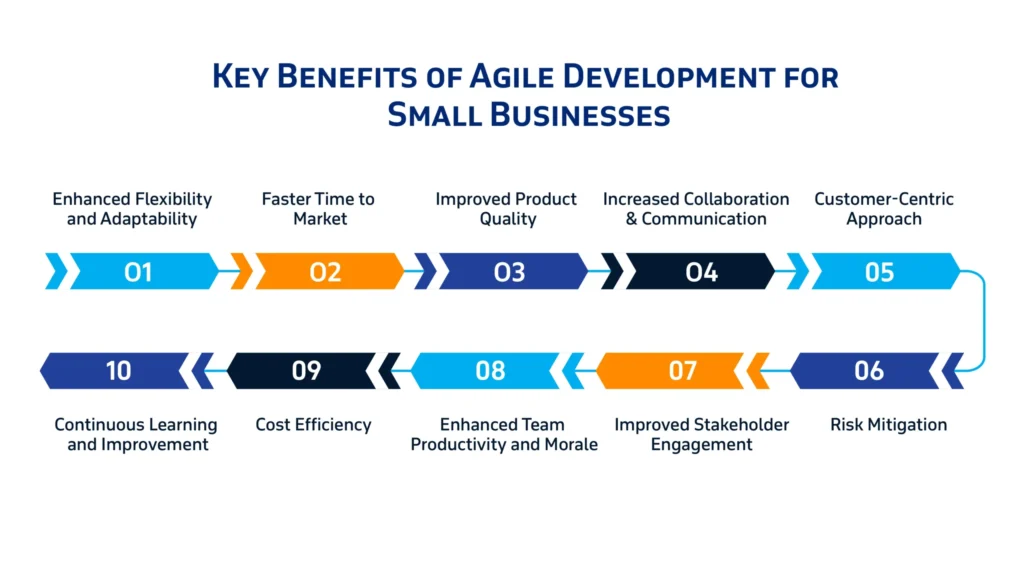Innovating Small Business Through Agile Development
Author: Laila Meraj
23 December, 2024
In today’s fast-paced business environment, small businesses face unique challenges that require innovative solutions and adaptive strategies. Agile development has emerged as a powerful methodology that can significantly enhance innovation within small enterprises.
This blog explores how Agile development benefits small business innovation, focusing on its adaptability, customer-centric approach, and the ability to deliver high-quality products quickly and the role of Xorbix Technologies in the agile development process.
Understanding Agile Development
Agile development is an iterative approach to project management and software development that emphasizes flexibility, collaboration, and customer feedback. Unlike traditional methodologies that follow a linear path, Agile allows teams to work in short cycles or “sprints,” enabling them to adapt to changes quickly and efficiently. This adaptability is crucial for small businesses that often operate in dynamic markets where customer needs and competitive landscapes can shift rapidly.
Agile Development Process

The Agile development process consists of several key stages that facilitate iterative and incremental software development. Here are the main phases:
1. Concept
This initial phase involves defining the project scope, identifying key requirements, and estimating time and costs. The product owner prioritizes projects based on business value and feasibility.
2. Inception
During this stage, the project team is assembled, roles are assigned, and a high-level plan is created. The focus is on gathering detailed requirements and establishing a project vision.
3. Iteration (Development)
This phase is where the bulk of the work occurs. Development teams create the software in increments, incorporating user feedback and making adjustments as needed. Each iteration typically lasts between one to four weeks.
4. Testing
After development, the software undergoes rigorous testing to ensure functionality, identify bugs, and verify that it meets user requirements. This phase is crucial for maintaining product quality.
5. Deployment (Release)
Once testing is complete, the software is deployed to production. This phase marks the transition of the product from development to live usage by customers.
6. Operations (Maintenance)
Post-deployment, ongoing maintenance is performed to address any issues that arise and to implement user feedback for future improvements. This stage ensures that the software remains functional and relevant.
7. Retirement
Eventually, when a product is no longer viable or needed, it enters the retirement phase, where it may be phased out or replaced by newer solutions.
Key Benefits of Agile Development for Small Businesses

1. Enhanced Flexibility and Adaptability
One of the most significant advantages of Agile development is its inherent flexibility. Small businesses often have limited resources and need to pivot quickly in response to market changes or customer feedback. Agile methodologies allow teams to adjust project priorities and scope without derailing the entire process. This adaptability enables small businesses to stay relevant and competitive in their respective industries.
For example, a custom software development company can leverage Agile practices to modify features based on client feedback during the development process. By incorporating changes early on, businesses can avoid costly revisions later and ensure the final product aligns with customer expectations.
2. Faster Time to Market
In today’s competitive landscape, speed is critical. Agile development promotes shorter development cycles, allowing small businesses to bring products or services to market faster than traditional methods. By breaking projects into manageable increments, teams can deliver functional components quickly, providing immediate value to customers. This rapid delivery not only helps capture market opportunities but also allows for early user feedback, which can be integrated into subsequent iterations.
For instance, custom web development projects can be launched with essential features first, enabling businesses to test their offerings in real-world scenarios while continuing to enhance the product based on user experiences.
3. Improved Product Quality
Agile methodologies emphasize continuous testing and integration throughout the development process. By regularly assessing product quality at each stage, teams can identify issues early and make necessary adjustments before they escalate into significant problems. This iterative approach leads to higher-quality products that meet customer needs more effectively.
For small businesses engaged in bespoke software development, this focus on quality is essential. By ensuring that each increment meets rigorous standards before moving forward, businesses can enhance customer satisfaction and build a reputation for reliability.
4. Increased Collaboration and Communication
Agile fosters a collaborative environment where team members work closely together across functions. Regular meetings, such as daily stand-ups or sprint reviews, encourage open communication and collective problem-solving. This collaborative spirit not only boosts team morale but also enhances creativity and innovation.
For small businesses employing software development services, this increased collaboration can lead to more innovative solutions. Diverse perspectives from cross-functional teams can inspire new ideas and approaches that may not have emerged in a more siloed environment.
5. Customer-Centric Approach
At the heart of Agile development is a commitment to customer collaboration. Unlike traditional project management methods that often involve minimal customer interaction until project completion, Agile encourages ongoing engagement with stakeholders throughout the process. This continuous feedback loop ensures that products are developed with the end-user in mind. Small businesses that prioritize customer input are better positioned to create solutions that truly meet market demands.
For instance, custom application development projects benefit from regular client feedback sessions, allowing developers to refine features based on real user experiences rather than assumptions.
6. Risk Mitigation
Agile’s iterative nature allows teams to continuously evaluate progress and identify potential risks early in the project lifecycle. By addressing challenges as they arise, small businesses can prevent costly setbacks and ensure smoother project execution. This proactive risk management approach gives small businesses greater control over their projects, helping them navigate uncertainty and unforeseen obstacles more effectively.
7. Improved Stakeholder Engagement
Agile promotes regular communication with stakeholders through sprint reviews and demos, keeping them informed about project progress and allowing for immediate feedback. This engagement builds trust and ensures that the final product aligns closely with business goals and customer expectations.
8. Enhanced Team Productivity and Morale
Agile methodologies empower team members by giving them autonomy over their work processes while fostering a sense of ownership and responsibility within cross-functional teams. This empowerment leads to improved morale, higher productivity levels, and better overall project outcomes.
9. Cost Efficiency
By delivering work in phases rather than all at once, Agile helps small businesses manage resources more effectively and avoid costly scope creeps. Early identification of issues allows for timely adjustments that minimize unnecessary expenses while maximizing return on investment.
10. Continuous Learning and Improvement
Agile encourages a culture of continuous learning through regular retrospectives where teams reflect on what went well and what could be improved in future sprints. This focus on learning fosters an environment where innovation thrives as teams adapt their processes based on lessons learned from previous experiences.
The Role of Custom Software Solutions in Agile Development
To fully leverage the benefits of Agile development, many small businesses turn to custom software solution development tailored specifically to their needs. These bespoke solutions allow companies to implement Agile practices effectively while addressing unique challenges within their industry.
Tailored Solutions for Unique Challenges
Custom software solutions are designed with specific business requirements in mind, making it easier for small enterprises to adopt Agile methodologies seamlessly. Whether it’s a custom mobile application or a web platform, these tailored solutions enable teams to implement Agile frameworks that align with their operational goals.
Scalability and Futureproofing
As small businesses grow, their software needs evolve as well. Custom software solutions developed with scalability in mind allow companies to adapt their systems without undergoing extensive overhauls. This flexibility supports ongoing innovation as new features or functionalities can be integrated into existing systems without disrupting operations.
Integrating Emerging Technologies with Agile Practices
The integration of emerging technologies such as artificial intelligence (AI) and machine learning (ML) into Agile practices can further enhance innovation within small businesses. By leveraging these technologies alongside custom software development services, companies can streamline processes and gain valuable insights into customer behavior.
Data-Driven Decision Making
AI and ML enable small businesses to analyze vast amounts of data quickly, providing insights that inform decision-making processes. When combined with Agile methodologies, this data-driven approach allows teams to prioritize features or enhancements based on actual user behavior rather than assumptions.
For example, using tools like Databricks Genie, businesses can harness data analytics capabilities within their Agile workflows, leading to more informed product iterations and improved customer satisfaction.
Enhanced User Experience
Incorporating AI-driven features into custom applications can significantly enhance user experience by providing personalized interactions and recommendations. Small businesses focusing on custom mobile development can utilize AI algorithms to create apps that adapt to individual user preferences, further solidifying customer loyalty.
Overcoming Challenges in Adopting Agile Development
While the benefits of Agile development are clear, small businesses may face challenges when transitioning from traditional methodologies. Understanding these challenges is crucial for successful implementation.
Resistance to Change
Employees accustomed to traditional project management may resist adopting new practices associated with Agile methodologies. To overcome this resistance, leadership must foster a culture of openness and continuous learning within the organization. Training sessions focused on Agile principles can help team members understand the benefits of this approach while encouraging them to embrace change as an opportunity for growth.
Resource Constraints
Small businesses often operate with limited resources, making it challenging to implement comprehensive Agile practices fully. However, even minor adjustments, such as adopting iterative planning, can yield significant improvements in flexibility and responsiveness without requiring extensive resources.
Conclusion
Agile development offers numerous benefits for small businesses looking to innovate effectively in today’s competitive landscape. From enhanced flexibility and faster time-to-market to improved product quality and increased collaboration, the advantages are compelling for any organization seeking growth through innovation. By partnering with a custom software development company like Xorbix Technologies, small businesses can access tailored solutions designed specifically for their needs while leveraging cutting-edge technologies such as AI and ML for enhanced decision-making processes.
Read more related to this blog:




